|
present Book Reviews For Amateur & Avocational Archaeologists |
 |
|
present Book Reviews For Amateur & Avocational Archaeologists |
 |
Texas Archaeology & Anthropology (except Rock Art)
|
|||||||||||||||||||
| Home | Gallery | Latest Finds | Back to Main Book Review Index |

|
Digging Into
South Texas Prehistory: A Guide For Amateur Archaeologists by Thomas R. Hester Corona Publishing Company 1980 First ed. ISBN# 0-931722-04-7 paperback Digging Into South Texas Prehistory was first published in 1980. It is subtitled "A Guide For Amateur Archaeologists" and it is the subtitle that best describes the scope of this book. Written by Thomas Hester, professor emeritus in the Anthropology Department at UT-Austin and former Director of TARL, this book covers the archaeological record of South Texas and serves as an introduction to the prehistory of the southern region of Texas. What can be learned from this book can be applied to any region of the state as this book tries to get the "collector" to look at things in a different light. Much of what is said in this book is addressed to the "relic collector" in an attempt to bring a level of awareness to individuals that engage in this “enjoyable but destructive” hobby. I have been engaged in this “enjoyable but destructive” hobby for the better part of 30 years and have found myself on both sides of the issue. This one book changed my view of what I was doing and how I was going about doing it. I enjoyed the book because it did not scold or talk down to the reader but made the attempt, successfully I should add, to show that there is a better way, and that discovery without knowledge is empty at best. One small passage best illustrates this..."Somewhere along the line, one realizes that scientific contributions can be more rewarding than the accumulation of points in a cigar box" The book is broken down into seven chapters that range from archeological field methods through the peoples that inhabited the area, the artifacts types they made and used and the different periods, paleo, pre-archaic, archaic, late prehistoric, and historic that make up the South Texas archeological record. The section devoted to artifact types and their descriptions was very interesting and very well done. One chapter I found quite interesting explained the types of sites found in South Texas and covered some specific examples. However, the most interesting chapter was the first that covered, and in layman’s terms, explained Archaeological Field Methods and gave examples of site survey recording forms and lists of basic equipment needed in surveying and excavation. Included in this chapter is a section that, alone, is worth the price of the book. The chapter section titled “Some Basic Considerations In Excavation” should be required reading for anyone that wants to learn how things should be done and how to hopefully contribute to the archaeological record. The book is very well illustrated and extremely well written. It is a must have for anyone interested in Texas archaeology, especially the archaeology of southern Texas. In closing, I will say I have collected and been interested in Texas archaeology for the better part of 30 years and have had a copy of this book for 25 of those years. Digging Into South Texas
Prehistory is
currently out of print, but can be found on the web
in several places. Here's a link
to
Alibris, which lists several copies
which can be ordered at prices ranging from $12.60
to $63.00! reviewed by Joe
Trussell
|

|
The Prehistory
of Texas by Timothy R. Perttula Texas A&M University Press 2005 First ed. ISBN# 1-58544-194-5 cloth hardcover Right away, picking up this impressively printed book, you know you are in for something special. Ten years in the making, The Prehistory Of Texas, is filled with scholarly publications that define and explain every aspect of the book's topic. What a most-needed book this was! It had been 50 years since the publication of "An Introductory Handbook of Texas Archaeology" (Suhm, Kreiger, Jelks) as part of Volume 25 of the Bulletin of the Texas Archaeological Society. Perttula pointed out in the first chapter, "It is fair to state that more archeological investigations have been completed in the last two decades of the twentieth century than in the seventy-five years before then." And, it's hard to find current publications as they are always done in small print runs in diverse places. For the amateur and avocationalist, getting a professional perspective on archaeology can be a very tedious thing to do. This book pulls together Texas' best authors, and best publications in order to fulfill its goals. Perttula writes: "We had several goals in mind as we set about compiling this volume on prehistory of Texas--- a big job for a big state. Our primary goal is to record and communicate, in one accessible source, what has been learned (and what we still do not know) about all aspects of Texas archeology from about 1950 to 2000. Second, recognising the constantly evolving understanding of the prehistoric archeology of Texas as new sites are found and explored and new ideas are proposed, evaluated, challenged, refined and explored again, we view the book as a rare opportunity for professional archeologists working in Texas to take stock of what we know (or think we know) in a comprehensive way and to attempt to synthesize the very diverse character of the archeological asset in Texas." It would be hard for someone, anyone, to take in this whole book as you would a novel, or even a textbook. I'll be reading this book over years! Each section is worthy of independent study, a jumpoff point for further investigation. Instead of reading it all at one go, you'll keep on coming back to it: If Texas is your interest, this book will become a cornerstone of your archaeology library. Read and absorb this tome and you will be able to converse with the top professionals at their level. It's a treasure to read on a rainy day! And if you are learning to write for publications yourself, you'll find plenty of great references to quote from in this book! If you are a collector, or a newbie to the field, this book will answer nearly every single question you ever had about the ancients! (It'll raise 100x more new questions!) Quit thinking you know what's going on: Read this book and know the facts! Great books are not cheap, and
neither is this one! It retails for $100 and can be
ordered directly from A&M Press by
clicking here.
Would make an awesome gift! reviewed by Bob
Wishoff
|
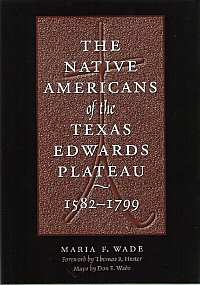
|
The Native
Americans of Texas Edwards Plateau
1582-1799 by Maria F. Wade University of Texas Press 2003 ISBN# 0-292-79156-9 paperback This is yet another fine volume in the Texas Archaeology and Ethnohistory Series, based on the doctoral dissertation of Maria Wade. It carries the serious weight of her years of scholarly research into the historical documents, anthropology, archaeology, anthropology and ecological backdrop of her subject matter---the Native American population of south and central Texas as encountered by the Spanish and French in the seventeenth and eighteenth century. The difficulties of translating the documents Wade deals with is considerable, due not only to difficulties in their physical condition, such as fading, inaccessibility and illegibility compounded by microfilming, but to the mindset of authors from another century with colonial and proselytizing agendas. As she so succinctly puts it, “...the majority of historical documents that include information about Native American groups do not deal with Native issues,” yet she manages to keep her focus on utilizing them to broaden our understanding of the Natives while clarifying their context. In chapters on the Bosque-Larios expedition of 1675 and the Mendoza-Lopez expedition of 1683-1684, she first gives a description of the archival materials she is working with and the rationale behind these incursions. She follows with a synthesis of the daily journal entries of the expeditions, pointing out textual ambiguities in the original Spanish version (or versions when more than one exists), followed by commentary extrapolating on waypoints and what can be gleaned about the Native population along the way, including a truly astounding number of individual group names. Interestingly enough, these entradas were at the instigation of Native groups seeking the establishment of missions, development of trade and protection from other hostile Native groups, though the resulting reality was often contrary to what either side was hoping for. Later chapters are devoted to a broader timeline based on archival material related to Natives of the Edwards Plateau, such as the records related to establishment of failed and successful presidios and missions, hostile contacts and retaliatory raids, the growing Apache threat, response to French incursions and inspection tours by representatives of the Crown and Catholic church. The significance of this ethnohistorical research with regards to the archaeological record is dealt with in a chapter delving into implications for the Toyah Interval and possible identification of the Jumano of recorded history with the Toyah cultures just beyond the historic horizon. The final chapter on “weaving the threads” of Spanish and Native histories, as well as determining the separate threads of Native components, offers some interesting insights as a result of Wade’s research. With regards to early settlements, “...first, they originated from within the fold of Native societies. Second, they were completely unsolicited and vehemently opposed by the European settlers. Third, they were neither a result of the direct intervention of Catholic minister, nor an attempt to bargain for rewards. Fourth, they were the result of a Native attempt to deal with social and cultural conditions that threatened the viability of their populations in ethnic terms.” The nature of Native group coalitions, dual ethnicity, information networks, and various Native resources as illuminated throughout the book are also summarized. An appendix includes extensive translations of several Spanish documents, which present insight into the bureaucratic mindset in which they arose. The 11 pages of informative chapter notes are also well worth perusing for the wealth of detailed analysis they offer, while the 19 pages of references speak volumes about the vast number of often obscure texts Wade has waded through in her research. The vocabulary is frequently challenging (this was, after all, the outgrowth of an academic thesis paper) yet indicative of the complexity of the issues dealt with. It is no a leisurely read, but certainly worth the effort for any serious student of the original interface between European colonialists and the Native population of Texas. The table of contents and full
introduction can be found here,
where you can also buy The
Native Americans of Texas Edwards Plateau for the web special price of
$26.77, hardcover. The introduction found at
this link is well worth visiting: Web pages for any
of the University of Texas Press publications all
link to lengthy excerpts which will further whet
your appetite for their quality offerings.
reviewed by Charles
Swenson
|
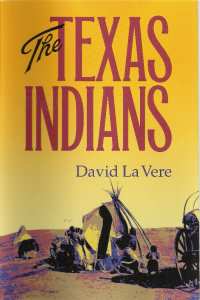
|
The Texas
Indians by David LaVere Texas A&M University Press 2004 308 pages, 30 B&W photos, 4 maps www.tamu.edu/upress ISBN# 1-58544-301-8 In 1961 the University of Texas Press published W. W. Newcomb’s The Indians of Texas: From Prehistoric to Modern Times. That it has withstood the test of time as one of the premier texts on the subject is evidenced that it is still in print 45 years later; that it is somewhat dated is also evidenced by references to “savages of the Western gulf culture area” and “barbaric gardeners.” David La Vere is professor of history at the University of North Carolina at Wilmington, acknowledges that Newcomb “was the first to really examine the Indians themselves and their own history,” but that he “would certainly agree that much new information on Texas Indians has come to light in the last forty years.” La Vere does an excellent job of incorporating the newer data in his wonderfully engaging The Texas Indians. His approach as a historian (Newcomb was an anthropologist) comes through in his presentation of the history of Indians in Texas as various native cultures evolving over time in response not only to a changing natural environment but the technological advances thrust upon them by the white man’s road. Dr. La Vere’s approach is much more historically linear. The first two chapters deal with prehistoric Texas natives, incorporating theories regarding man’s first arrival to the area and gradual transformation into the various cultural groupings and cities as they existed in the early 1500s. From this “arrival of strangers” on the focus is still on the Indian cultures but the presentation of the subgroups is tied into the historical record generated by their encounters with Spanish, French, American and Texan encroachment. The Karankawas, Coahuiltecans and Jumanos are first discussed at length in the context of Cabeza de Vaca’s encounters with them, giving a feel of these tribes as they existed prior to being overwhelmed by Western individuals without the advantages of their more technologically advanced society. The flow of history leads later to discussing the gift-giving based economic systems which led the tribes to bind with the Spanish for exchange of trade items (firearms, metal tools, manufactured cloth for hides and food items such as corn, beans and potatoes). The grievously unbalanced “great biological exchange” of bacteria and disease played its role as well, so that within 350 years after de Vaca’s first encounter with them these groups had been assimilated into other tribes, been hispanized or simply wiped out. Similarly other tribes are introduced as they began to be encountered in their historical context, sometimes to grow in influence but all ultimately fated to wane to their current status, with the possible exception of the Tiguas, Alabama-Coushatta and Kickapoos as their reservations emerged as centers for organized gambling in Texas. (These ultimately were also waylaid and played against each other while attempting to travel the white man’s road by lobbyist Jack Abramoff, but that is a story beyond the scope of this book.) Dr. La Vere expertly weaves into Indian history the significance of hostile intertribal conflicts that were exacerbated and manipulated by non-Indian influences, as well as the convergences of new groupings. He manages to incorporate the larger Southwest into the picture as other non-Texan Indian groups were forced into Texas in a futile attempt to escape the fate of reservation life, as well as bringing to light the difficulties they encountered when eventually forced onto the Oklahoma reservations, or the less well known but short-lived Clear Fork and Brazos reserves in Texas. All in all Dr. La Vere has managed an eminently readable text, scholarly in it’s mastery of the facts yet satisfying to the lay reader as well. It is destined to become a classic worthy to sit alongside Newcomb’s not only as a standard reference for students of Texas Indians but anyone interested in a wider grasp of Texas history. The Texas Historical Commission named it winner of the 2004 T. R. Fehrenbach Book Award for “original research and publication of material that preserves, records and recounts the prehistory and history of Texas,” and it received the 2005 Philosophical Society of Texas Book Award for best book published on Texas. La Vere is author of three other books --- Contrary Neighbors: Southern Plains and Removed Indians in Indian Territory (University of Oklahoma Press, 2000, awarded the 2001 Oklahoma Book Award for Best Non-Fiction), Life Among the Texas Indians: The WPA Narratives (Texas A&M University Press, 1998), and The Caddo Cheifdoms: Caddo Economics and Politics, 800 AD – 1835 (University of Nebraska Press, 1998). The working title of his latest work in progress is Grave Robbers: The Looting of Spiro Mounds, and promises to be of especial interest to issues arising with regards to issues related to avocational archeologists. The Texas Indians
retails for $29.95 and is available directly from the
Texas A&M University Consortium by clicking here.
reviewed by Charles
Swenson
|
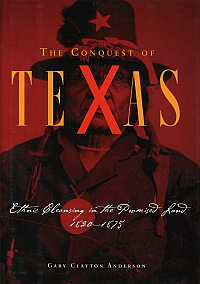
|
The Conquest of
Texas: Ethnic Cleansing in The Promised Land 1820-1875 by Gary Clayton Anderson University Of Oklahoma Press 2005 1st edition ISBN# 0-8061-3698-7 cloth hardback The term "ethnic cleansing" entered the English lexicon as a literal translation of a Bosnian/Serbian/Croatian phrase. During the 1990s it was used extensively by the media in the former Yugoslavia in relation to the Yugoslav wars, and appears to have been popularised by the international media some time around 1992. The term may have originated some time before the 1990s in the military doctrine of the former Yugoslav People's Army, which spoke of "cleansing the territory" of enemies to take total control of a conquered area. The origins of this doctrine are unclear, but may have been a legacy of the Partizan era. At the most general level, ethnic cleansing can be understood as the expulsion of an "undesirable" population from a given territory as a result of religious or ethnic discrimination, political, strategic or ideological considerations, or a combination of these. This explanation, quoted from Wikipedia, of what the term "ethnic cleansing" means is relevant because author Anderson takes great pains to articulate not a genocide of Indians, but an evolving policy, in a violent culture, by early Texans to push out not only Indians, but also Tejanos and other non-whites from the new territory. Texas was effectively at war for over 50 years, "the longest continuous struggle of its kind in American history." "Although the following statement may seem "presentic" to some, in hindsight the conflict can be seen for what it was: an Anglo-Texas strategy and a policy (at first haphazard, debated, and even at times, abandoned) that gradually led to the deliberate ethnic cleansing of a host of people, especially people of color." And so, the author begins to relate an alternative history of the state of Texas, one that has not been told, and one that will shock most avid followers of Texas lore. The author desperately wants to end the "myth of Texas," to make us all see it for what it was: a real estate rush by a people who tended toward violence and deception. The Texas Revolution is peopled by those who meant well in the beginning, but who became more vicious as time when on, even advocating extermination at one point. Modern analysis of what comprises ethnic cleansing, an entirely new concept, provided new insights into how to categorize these events in Texas' history and Anderson takes full advantage of the latest research. Anderson especially seems to want to end the heroic stature of the Texas Rangers, whom he believes were largely uneducated, unemployable ruffians, who, hired without pay, rode out for the plunder they could bring home, and tended toward behaviors like rape and the shooting of Indian women and children for sport. Indeed, the author believes they were exhorted to do such things! Vague boundary lines between territories, policymaking by rumor, true renegades, and a broke Republic all serve to stir up the worst in human behavior. That both Indians and Tejanos were living on farms, tending animals, doing trade and quite possibly held the same future in their hearts was a view rationalized away by the Anglo-Texans. All of the heroes of the Texas Revolution seemed to have had ulterior motives for everything they did. The history of Texas gets darker and darker with every chapter you read. No matter that it's painful for you if you are a Texan, you'll still read every page. This is a hard book to put down! This is drama of high order, myth shattering stuff. Texans were certainly urged to be paranoid. Between worrying that Mexico was trying to make allies of Indians and Tejanos already in Texas territory, settlers were besieged with rumors and innuendo designed to alarm and result in revenge raiding parties for Indian or Tejano acts which were total fabrication, dreamed up by Texas' leaders desperate to get the US to intervene and make Texas a state. All this fearmongering created an environment which pushed most all Indians out of the territory by 1870 and caused the ruin of many loyal Tejanos. Houston, Lamar, Baylor, no one escapes the pen of Anderson! Here is a richly researched book that will keep tongues a-wagging for a long time to come. The notes and bibliography will send you off to do your own fact-checking. There's just too much in The Conquest of Texas to pull out a few lines as representational: You'll either be nodding your head in agreement, or howling in pain at this rethinking of all of your heroes. I found this book to be one of the most thought-provoking books about Texas history I've ever read. If you haven't read it, you simply just don't know the whole story. If you walk away without an opinion, well, then, you must have died while reading it. Another must-have book to add to the library! Quick, order one of these
books before they sell out! Order The Conquest of Texas direct from University of Oklahoma
Press for $29.95 by clicking here.
reviewed by Bob
Wishoff
|
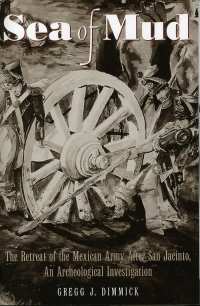
|
Sea of Mud:
The Retreat of the Mexican Army after San Jacinto, An Archeological Investigation by Greg J. Dimmick Texas State Historical Ass'n 2006 First ed. ISBN# 0-87611-215-7 paperback Sea of Mud, is not only a fascinating look at an important element of the fight for Texas independence, but also a look at one man's obsession with archaeology, and his journey from collecing artifacts to doing serious professional-quality research. Dimmick, a pediatrician from South Texas, was invited to visit a local ranch and seeing the owner find a few minnie balls and other relics, promptly got hooked. This was in 1996, and Dimmick's life would come to be profoundly changed by his experiences in the field. Working with the Houston Archeological Society, and starting from the position of "sifter monkey," Dimmick learned the ropes of general field work. "I decided I had to know more about the Civil War in our area to see if there were other sites to be located and documented. Please let me stress the "documented" part of the equation. Artifacts with no provenance or historical record are interesting but are of no real historical or archeological value. Having found very little information on the Civil War in our area (not too surprising considering how little action actually took place in our neighborhood) I decided to expand my horizons." "Out of the blue, I decided to try to find evidence of the Mexican army. With absolutely no knowledge of where exactly they had been in our area, or any awareness of any previous artifacts found, I got this crazy idea in my head that we might be able to find some remnant of the Mexican army from 1836." What follows is an incredible story of the Mexican retreat at the end of the war that is both a detective story and a moving story in intimate detail of a bitter rivalry between Mexican generals, all told in their own words. This book is the result of literally thousands of hours of patient excavation, tedious hours spent in libraries, and difficult translations of hundreds of letters and documents. How what should have been a small setback for the Mexican army resulted in Texas independence will keep you reading on and on till the end of the book. This book proves, as another reviewer put it that "Mud was the ugly midwife of the infant Republic of Texas." The undertone for the entire book, however, is how an avocationalist archaeologist with little experience can indeed set out to uncover important facts about history and create contributions of great significance to our understanding of past events. Need I say that Dimmick states he practices medicine to fund his future archaeology activities? This book is a wonderful addition to any library of
historical materials. reviewed by Bob
Wishoff
|
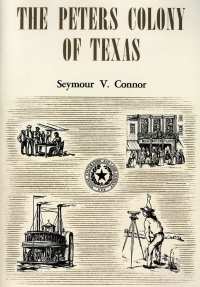
|
The Peters
Colony of Texas by Seymour V. Connor Texas State Historical Ass'n 2005/ reprint of 1959 ed. ISBN# 0-87611-206-8 paperback This reprint is significant because for years and years this book has been impossible to locate, and when it was located, available only in non-circulating library collections. If you have ever held the belief that life was easier in the "old days," this book will surely change your mind. Filled with exhaustive detail of every facet of life in the colony, this is a tale of pioneers stubbornly overcoming every sort of imaginable setback and hazard on Texas' largest land grant of over 16,000 square miles. If you are a Texan researching your lineage, then this book could be of interest as fully one-half of it is comprised of biographical sketches of the colony's inhabitants. Researching litigation histories in pioneer America? Well, this book is loaded with cases of frustrating tangled tales of law and litigation. Or maybe, you are interested in how land grants were organized and worked--- this is the book for you. I've never read another book like it--- the research for it must have taken great patience. Its scope runs from the beginning of 1841 through 1957! Author John H. Jenkins, in his book, Basic Texas Books, calls this book the "best study of one of the largest land grants in Texas history." The Peters Colony of Texas is definitely a significant book of Texas history. Third in a series of Texas Reprints, the book
retails for $30.. and can be ordered direct from the
TSHA/A&M University Consortuim by clicking here.
reviewed by Bob
Wishoff
|
 New Third Edition! 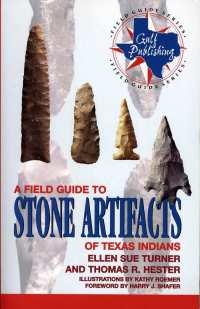 Still available second edition.
|
NEW EDITION!!! Stone Artifacts of Texas Indians by Ellen Sue Turner, Thomas R. Hester & Richard L. McReynolds Foreward by Harry J. Shafer Taylor Trade Publishing First ed. 2011 ISBN# 978-1-58979-464-1 oversized paperback Finally, a new edition of a book everyone interested in Texas archaeology can celebrate! In this edition, Richard McReynolds is given co-authorshipand his fine illustrations more than round out this exemplary book. Still a guide, the title no longer sports the "Field Guide" label because it is now a full 8-1/2" x 11", hardly a "backpack stuffer"! This book has always been an invaluable reference, but the new edition's size also makes it a great browse-able read for all audiences and might actually attract new interest to Texas archaeology. When necessary, typological and chronological information about all of the stone artifacts have been updated to reflect the latest available knowledge. Stone Artifact of Texas Indians is quite simply the best general reference on Texas lithics, period. The book is widely available, both at brick-and-mortar establishments such as Barnes & Noble and also from web-based sites such as Amazon.com. Full retail price of Stone Artifact of Texas Indians is $29.95, but if you click the link above and go to Amazon, you can pick up a copy for $18.63. A Field Guide To Stone Artifacts of Texas Indians by Ellen Sue Turner & Thomas R. Hester Foreward by Harry J. Shafer Illustrations by Kathy Roemer Gulf Publishing First ed. with Gulf ISBN# 0-89123-051-3 paperback "What did I find?" If I only had a dime for every time I get asked that question! For artifacts found in Texas, there's really only one great reference to check, and that's this book. Easy to find at most large bookstores all over Texas, there's little doubt that you'll need to buy two copies--- one for the home and one to take out into the field. I used to like photographs of artifacts best for IDing, but over the years, have learned that it's the subtle flaking patterns you want to study, and drawings are much easier to interpret than pictures for this detail. This book is loaded with clear, accurate drawings of every type of lithic found in Texas. Accompanying the drawings are clear, concise descriptions for each type of lithic, with distribution shown on small maps. Read the introduction and get a quick summary of manufacturing techniques, context and chronology for Texas artifacts. The bibliography is a fantastic source for your future investigations. This book is a must-have for all parties interested in Texas lithics and is very economical to buy at only $17.95. Pick it up at Amazon for only $12.95! reviewed by Bob
Wishoff
|
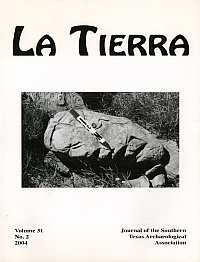
|
La
Tierra: Journal of the Southern Texas Archaeological Association edited by Thomas R. Hester & Harry J. Shafer Quarterly/Biannual publication ISSN# 0163-0695 paper Reading journals and publications is a great way for amateur and avocationalists to keep up with current excavations and current thinking in the world of archaeology. Book publication is almost certain to publish summaries of years-old work, while journals are published quarterly or bi-annually, and thus, frequently contain mre recent materials. If one is serious about practicing the discipline,
publication of ones' work brings to fruition the
purpose of any true research: communication!
Over its 30+ years of existence, nearly every facet of archaeological research has been documented in the pages of La Tierra. Online and on-demand downloadable versions of journals published from the 1970's through the present are currently being scanned to provide unprecedented access to information for STAA members. Selected copies of the journal are already available for sale online, by non-members, at the STAA website. La Tierra is free with
STAA membership --- Click here to sign up for
membership online and to view available back issue
Journals for sale. reviewed by Bob
Wishoff
|
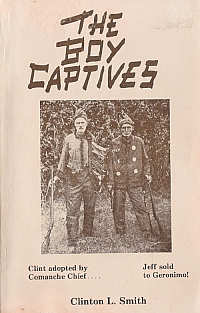
|
The Boy
Captives by Clinton L. Smith San Saba Printing and Office Supply 12th Printing 1998 ISBN # 0-94369-24-9 Captured
In many small convenience stores throughout Central Texas a locally published book can still be found sitting on the magazine shelves next to the latest offerings of glossy mass media ephemera. It was first promoted in Frontier Times in 1927 and later offered for sale by the author at the Old Trail Drivers Association meeting in San Antonio that year. It has gone through at least 12 printings since then, and is still distributed by direct descendants of the author. It is best known as The Boy Captives, but in a style rarely seen anymore it is even more fully described on its title page as The Boy Captives, Being the True Story of the Experiences and Hardships of Clinton L. Smith and Jeff D. Smith among the Comanche and Apache Indians During the Early Days- The Only Two Brothers Ever Known to Endure and Same Hardships of Captivity and Get Back Alive. ---A Thrilling Tale of Savage Indian Life and Captivity Truthfully Fold by the Captives Themselves ---Tragedies of the Borderland and Perils of the Frontier Depicted. Their tale of being taken by a group of Comanche and Lipan Apache, Clint’s adoption by a chief and Jeff’s sale as a slave to Geronimo, two years of life as Indians their reluctant return to their previous lives is one of the few first hand accounts of such adventures. It was originally penciled by Clinton Smith in collaboration with his illiterate younger brother Jeff (who was never able to adjust to school after his return from captivity) by lamplight on a Big Chief tablet. On completion it was hand delivered to J. Marvin Hunter of Bandera, who helped publish what he felt was “a splendid contribution to history – an inestimable legacy and gift to posterity, as rare and timely as truth is mighty and eternal.” Clinton’s wife Dixie hoped that sales of the book might lift them out of poverty, but the Comanche trait of generous gift giving was so deeply embedded he gave most of the copies away to friends and refused money for them. He divorced from Dixie soon afterwards, again nomadic and living with various family members until his death in 1932. Hunter chose to “adhere as strictly as possible to the manner of expression, the style of recital and the method of description used by Mr. Smith.” This produced a manuscript that is sometimes described as quaint or homely, but in reading it feels as though you are sitting there listening to Smith as an old-timer anxious to let you know just what his time among the Indians was really like. His sympathy for the rapidly vanishing lifestyle of the Comanche is clear and almost painful at times. The experiences of Jeff and Clint Smith are unique primarily because they are still known, mostly because of The Boy Captives. Adolph Korn, captured the year before and returned to society at about the same time as the Smiths, was almost completely forgotten by even his family. His disintegrating tombstone and fast fading family memories captured the attention of a distant nephew, Scott Zesch. “Uncle Korn” is now the pivotal point of an in-depth study of nine children captured by Southern Plains Indians in Central Texas from 1865 to 1877, including the Smiths. The Captured – A True Story of Abduction by Indians on the Texas Frontier is an eye opening look at the vast gulf between the white and Indian experience encountered by thrown by circumstances beyond their control between the two. We now speak of the Stockholm Syndrome to describe the embracing of the captors point of view by those captured, and a similar empathy arose in the captured, compounded by the ongoing development of their young psyches. The violence of their abduction, often witnessing horrendous deaths of family members and siblings, was often tempered by an eventual kindness by their new families. Their new lives also often granted them opportunities and freedoms far beyond the hard scrabble frontier life they’d come from. It was not uncommon that the captives actively fought assimilation back into white society, at least one eventually returning to live with the tribe that was now more a part of him than the white man’s world. Adolph Korn is one of those who did not assimilate well back into the world he had been born into. He rarely spoke of his experiences with the Comanche, and the only account of his time among them is found in The Boy Captives; Smith came across him and other captives during his time as an Indian, and described him as “about as mean an Indian as there was in the tribe at that time.” A deposition Korn gave when called upon to testify in an Indian depredation case was the closest to a public statement he ever gave, and he denied any participation in raids, perhaps fearful of retribution. After numerous small jobs he did eventually buy property in Mason, Texas and seemed about to settle down. But this was not to last. He became increasingly reclusive and eventually withdrew completely. He spent his final days as a hermit living in Diamond Holes, an old Comanche hideout in a series of small caves on a bluff above Rocky Creek in outside of Hilda, Texas. Zesch has done a masterful job of researching his subject, no easy task since most of the captives had died earlier in this century, and even most who’d known the captives were themselves passed on. Those in his own family who’d known Korn personally were dead by 1970. But in 45 pages of footnotes, bibliography, acknowledgements and “a comment on the sources” show that Zesch shows his dogged pursuit of a trail that seemed to have gone cold long ago has brought forth living, breathing characters. It is rare that two books compliment each other so well; anyone who has been fortunate enough to read Smith’s book will find much background in Zesch’s, while those who read Zesch’s will find the sort of story he wished his Uncle Korn had been able to tell him in Smith’s, straight from the horse’s mouth. Note: The Boy Captives is available over the internet only as a used book, fetching upwards of $22 on Amazon. However, if you don’t come across a copy at one of those backwoods Central Texas convenience stores, it is still distributed by one of Clint Smith’s direct descendants; his ex-wife Dixie would be glad to know that it is still bringing money into the family coffers. You can write for it to Clint Smith, HC 87, Box 62A, Junction, Texas 76849; or call 915/446-2086 or 800/523-4277. Captured can be ordered
directly from the publisher's ditributor for $14.95 by
clicking here.
reviewed by Charles
Swenson
|
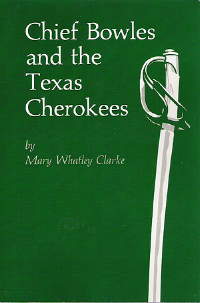
|
Chief Bowles
and the Texas Cherokees by Mary Whatley Clarke University Of Oklahoma Press 1971/2002 1st reprint ISBN# 0-8061-3436-4 paperback Chief Bowles, leader of the Texas Cherokees, friend of Sam Houston, engineer of the failed Cherokee Land Grant in East Texas, was one of those great figures of the early 19th century struggling for peaceful coexistence with white settlers but ultimately driven to war against them. Much has been written about him, but the late newspaper publisher and author Mary Whatley Clarke wrote his only biography in 1971, republished in 2002 by the University of Oklahoma Press as part of their Civilization of the American Indian Series. Born in 1756 as Diwa’li (‘bowl’), one of twelve half-breed children raised by a Cherokee mother and Scottish trader in North Carolina, he was brown haired and blue eyed, but clearly considered himself as Cherokee. His parents were murdered by white settlers when he was 14, after which he moved to the town of Running Creek on the Tennessee River. At the age of 36 he rose to the position of chief after the death of the previous chief, but within two years a dispute with riverboat traders led to the deaths of several Indians and white men, as well as the capture and ultimate release of some women and slaves traveling with them. Rumors blew this up into a full blown massacre, with both Cherokee and federal government authorities seeking his arrest on charges he would later be exonerated of. Bowles and his followers departed for southeastern Missouri, seeking refuge and new lands to settle in peace. Bowles and his group lived in Missouri until the Great Earthquake of 1811 wreaked massive changes on the landscape, after which they fled to Arkansas until federal survey claims forced them out of their settlements in 1819. They eventually settled about 50 miles north of Nacogdoches area in east Texas and established a confederation with local refugee tribes, including Shawnees, Delawares, Kickapoos, Choctaws, Biloxis, Alabamas, Coushattas and other Cherokees. Bowles, acting as chief for this alliance, was determined they would never again be driven away from their lands. Along with other council members, he made multiple trips to San Antonio, Saltillo and Mexico City, seeking to obtain title to the lands they were successfully farming and raising cattle on. They received many reassurances and promises of a land grant from the Mexican government, even declining participation in the Freedonian Rebellion when promised land by leaders of this failed attempt at secession from Mexico. While being allowed to remain on their lands, they never received clear legal assignation of their lands. Sam Houston was a longtime friend of the Cherokees and Chief Bowles at the time of the Texas Revolution, and their mutual amity was essential to its success. The early Texian setbacks at the hands of Santa Anna might have been fatal for the new Republic if not for the neutrality of the Texas Cherokees, attained by a treaty with the Provisional Government of Texas promising them deed to their lands. Once the Republic of Texas was established Houston made valiant efforts as its first President to honor previous commitments to Bowles and his people, but his efforts were thwarted after Mirabeau Lamar, who’d previously been instrumental in the removal of Cherokees from Georgia, became President and declared the Cherokee Nation claims ‘null and void.’ Rumors of secret alliances with the Mexicans before and after the Revolution persisted, fueled by the hunger of new settlers for the rich lands of the Texas Cherokees. The massacre of 18 members of the Kilough family on lands within the Cherokee territory made many white settlers unwilling to tolerate an Indian presence in their midst, and the new government resolved to move them out. So in 1839, only twenty years after arriving in Texas, Bowles and his peoples were again faced with forcible removal from Texas, taking only what they could carry, not even being allowed to harvest their last crops. This was too much for the 83 year old Bowles, who refused to leave without a fight. He and some 800 warriors of various tribes were defeated by 500 Texas militiamen in a battle that stretched over two days. After signaling a final retreat, Bowles had his horse shot out from under him, and was then shot in the back while walking away. As he sat wounded on the field, wearing the red sash, vest and sword given him by Houston as signs of lasting friendship, a Texan captain placed a gun to his head and killed him on the spot. He was scalped, strips of skin cut from his back for horse reins, and his body left on the battlefield (tribal custom precluded funeral ceremonies for scalped warriors), where his skeleton and skull could be seen for years afterward. Chief Bowles had finally found his place of rest among the whites who sought to drive him out. Clarke’s newspaper background,
operating all aspects of the weekly Palo Pinto
County Star by herself, served her well as the
author of this volume, as well as of seven other
books and numerous magazine articles. Her
bibliography makes clear the wide variety of
materials she drew on in researching her book,
including contemporary newspaper accounts,
university and private archives, government
documents, journal articles, books and
interviews. It remains the standard and much
referenced biography of Bowles, and is available
from the University of Oklahoma Press here
for $19.95. reviewed by Charles
Swenson
|
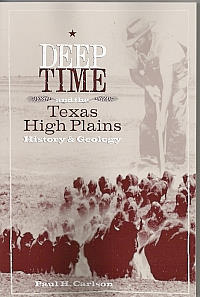
|
Deep Time and
the Texas High Plains: History and Geology by Paul H. Carlson Texas Tech University Press 2005 ISBN#0-89672-553-7 paperback The original title of this book was Deep Time and the Lubbock Lake Landmark: History and Geology in the Upper Brazos River Region, but this would make little sense to those unfamiliar with Lubbock or Texas Tech. Primarily it’s about the Lubbock Lake Landmark, a Paleoindian site located on the Yellow House Draw, referred to in archaeological literature as the Lubbock Reservoir site, the Lubbock Locality and the Lubbock site; for a brief period it was even the Lubbock Lake National and State Archaeological Landmark. Confusing? Yes, and this book arose out of the author’s desire to make the history of this site clearer to visitors at the site. And it is a complete history, from the Big Bang to the growth of a modern Texas Panhandle city around it. The description of the planetary and local geological processes that gave rise to the Llano Estacado and its biological backdrop are well covered in the first chapter. The Clovis culture that flourished in the area, as well it’s evolution through the Folsom, Plainview and Firstview periods are considered in the second chapter, with interesting sidebars on pre-Clovis cultures, the more well known nearby Blackwater Draw and Plainview buffalo kill sites and Pleistocene extinctions. Climatic shift towards drought and the effects of subsequent changes in flora and fauna on human population are then covered, again drawing on archaeological findings from the Lubbock Lake Landmark site to emphasize what we now know about this Archaic period in the third chapter. The Ceramic, Protohistoric and Historic components of the past two thousand years are covered next, with considerations of the major changes brought by agriculture and then European culture as they arrived on the scene. Finally the effect of the past two hundred years is covered, a period that of no less consequence though much more well known, seeing the creation and disappearance of the manmade Lubbock Lake over the site with its biological considerations. It was used then as a firing range, Boy Scout Camp, Marine training area, motorcycle course and even as a caliche quarry for a short period of time before concern for preservation of its unique qualities led to it’s current status as an archaeological and natural history preserve. Visitors to Lubbock Lake Landmark now have a succinct guide to the “deep time” on display at the site. The real value of this book lies in its wider applications to the upper Brazos River drainage area (which does include the more famous Clovis and Blackwater Draw sites) and the Llano Estacado in general, as well as a meditation on the implications of modern development on sites of major paleontological and archaeological importance. Their web site has full information as to when it’s open and more of what is available there to anyone inspired by the book to visit this significant archaeological landmark. Deep Time In The Texas High
Plains is available, for $19.95, direct from the
publisher by clicking here.
reviewed by Charles
Swenson
|
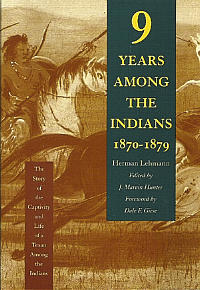
|
9 Years Among
the Indians, 1870-1879 by Herman Lehmann Edited by J. Marvin Hunter, Foreword by Dale F. Giese University of New Mexico Press 1927, 1993 ISBN#0-8263-1417-1 paperback Indian captive stories were an early mainstay of American literature. One of those, Clinton Smith’s The Boy Captives, has been reviewed here, together with a more recent retelling of the virtually unpublicized captive story of Adolf Korn by a distant relative, Scott Zesch’s The Captured. Hermann Lehmann’s retelling of his own story, 9 Years Among the Indians, is not only another great book in the same vein, but fits in so well with the others that they should all be read together. There is an almost uncanny similarity between the stories; stories of young pre-teen boys captured in the same area of Central Texas between 1870 and 1871 who at even met each other while held captive by the Comanche, undergoing a “Stockholm Syndrome” sort of conversion where they came to eventually consider themselves Indian, actively fighting eventual repatriation to their families of birth, struggling unsuccessfully to live again in a white man’s world where they always felt somehow apart. Hermann and his brother Willie were captured by a band of Apaches in May of 1870; his two sisters barely escaping the same fate and his brother escaping a few days later. After enduring months of harsh treatment and a futile attempt at escape, he ultimately came to accept his new life and to be accepted by his captors as one of them. He began to take part in raids on farms and ranches, learned to drink, kill and scalp, even fighting as a warrior in skirmishes with Comanches and Texas Rangers along the way. But he barely escaped with his life from his Apache band after killing their medicine man in a drunken brawl which also took the life of his master and best friend. After living alone in the wilderness for almost a year with only his horse as companion, he decided to risk joining a band of Comanches. Afterward he came to consider himself as Comanche, living with was Quanah Parker as a member of his family for three years. He continued to participate in warfare with other Indian bands and raids on the whites, but these were hard times for this once proud tribe, much of it spent on and off of reservations before their final defeat at the hands of General McKenzie. Ultimately Lehmann was convinced by convinced by Parker to return to his family of birth, part of the same hard deal that was demanded by the Fort Sill Indian Agent Lawrie Tatum that also brought in the Adolf Korn and Clinton Smith. Like Korn and Smith, by the time Lehmann was returned to his first family he had forgotten his first name and was unable to speak even a word of his first language. He did eventually finally assimilate back into society for a time before moving to Oklahoma to live on the Comanche reservation. He even wrote a memoir in 1899 in conjunction with Jonathan Jones, a Central Texas school teacher. Entitled A Condensed History of the Apache and Comanche Indian Tribes for Amusement and General Knowledge, though simply called Indianology on its cover, this bizarre account of his life in captivity never sold well and Lehmann felt it never accurately conveyed his experiences. But after some success on the county fair circuit back in the Texas Hill country and a renewed public interest in Indian captive stories, a second book on his life was finally published in 1927. Written in collaboration with Marvin Hunter, 9 Years Among the Indians was largely based on a week’s worth of interviews and containing generous portions of plagiarized material from the earlier Indianology. Presented in the first person it has a homey feel to it, almost as if you were listening to Herman himself telling the story. At the same time he is telling the story of the people he lived with for almost a decade, giving voice to the failing struggle to maintain a way of life that had become his own. As he sums up in the final chapter… “I have now given the reader the story of my life, which has been so eventful. There are many little incidents and details which have been omitted, because if they were all told it would require a book many times the size of this volume. Enough has been told, however, to give the reader an insight in the manners and customs of the Comanche and Apache tribes of Indians. I was one of them, and I have told this story truthfully.” This is a book that anyone who has speculated what life with those Indians was like during their final days before being driven onto the reservations, and just how devastating giving up their way of life was to them. This is truly one of the great (and last) of the Indian captive narratives told by a survivor, a vision into a vanished way of life that is a treasure it is invaluable from a humanitarian as well as a historical point of view. Originally published for $3.00 in 1927, it is now available in paperback for $18.95. This University of New Mexico Press edition, with over 262 pages and photographs of Lehmann and many of his Indian compatriots, is available from the book’s website here. Together with The Boy Captives and The Captured (see above reviews), this is one of the best books out there on this little understand chapter of American frontier life. reviewed by Charles Swenson |
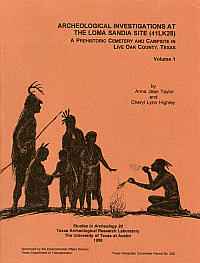 |
Archeological
Investigations at the Loma Sandia Site (41LK28):
A Prehistoric Cemetery and Campsite in Live Oak County, Texas by Anna Jean Taylor and Cheryl Lynn Highley Texas Archeological Research Laboratory, The University of Texas at Austin 1995 ISBN 1-887072-08-X Paperback One of the most eye-opening things an avocational archaeologist can do is to look at the tremendous amount of work that goes into a professionally excavated site. This volume, one of 42 available from TARL in their Studies in Archeology series, is a window into not only the research methodology used, but of the astounding amount of information that can be gained from 13 month’s worth of intensive investigation at a site. At 846 pages in two volumes (not including a separate map packet) it is very dense reading, with arcane discussions on topics such as use-wear evaluation of points, spatial analysis of skeletal remains by fluoride groups, and a daunting number of full page provenience tables in fine print. Although it is not a casual evening’s reading by any means, anyone with a serious interest in the archaeology will find this sort of material enlightening. Any avocationalist with an interest in Central Texas mortuary practices would do well to read this volume. Aside from the more esoteric aspects of this tome there is much valuable (and more readily comprehensible) information to be garnered by the alert lay person. The site was studied “in order to mitigate the effects of construction” by a nearby highway, an all-too-common reason for archaeological research--- Cultural Resource Management archaeology. Evidence of use and occupation from Paleo-Indian to late Prehistoric times was also found, but of particular interest was it’s utilization as a cemetery site, with skeletal remains of over 200 individuals which were spatially mapped as exposed, then eventually exhumed. Cultural features at the site included grave pits, non-grave pits, mortuary items, non-mortuary artifacts, ocher, ocher stains, charcoal stains, organic stains, burned rock, possibly burned clay, a banking cache probably dating prior to the site’s use as a cemetery, some ceramics and artifact clusters which may have been indicative of areas of various activities/behaviors. Radiocarbon dating and artifact chronology indicated that the burial site was late Middle Archaic, in use from approximately 850 to 550 B.C. The skeletal remains were poorly preserved due to bioturbination, but were established to be half male, half female with no spatial differentiation noted in relation to sex. A wide variety of mortuary items were found in association with the skeletal remains, including pendants, flaked, chipped, pecked and ground stone artifacts, including projectile points, hammerstones, manos and grinding slabs placed over some of the remains. The ocher staining was generally associated with either the skull, the pelvis or the legs in the 13 skeletons where association was found. Additional items determined to be mortuary items incuded stone pipes (some with asphaltum utilized to attach to stem pieces still intact), fresh and salt water mollusk shells, shark and stingray teeth, bone and antler. The most outstanding of the burials, was a young adult male found with a grinding slab and hearth placed over his site, adorned with a deer skull with intact antlers which may have indicated a socially differentiated status within the community. The nature of mortuary items is also discussed at some length focusing on the limitations encountered by hunter-gatherer individuals when faced with transporting personal possessions of the deceased. Individual items, especially of a larger nature would most likely be left behind, but what can be made of larger collective items such as grinding slabs being buried with individuals? As with any good archaeological site, more questions are raised than are answered. An incisive overview of the material presented is found in a foreword by that "godfather" of modern Texas archaeology, Thomas Hester. Extensive chapters on “Archaeological and Ethnohistorical Background,” “South Texas Prehistory and the Loma Sandia Site,” and “A Perspective on Some Prehistoric Cemeteries in Texas: Loma Sandia in the Regional Setting” provide a solid grounding in previous research related to the material. Chapters on research designs and methods, geoarchaeology and “Controlled Excavation Areas” present the nature of the work being done, and while most non-professionals may want to skim over these, they hold interesting insights into the nuts and bolts of just what modern archaeology entails. The lion’s share of the book is devoted to the skeletal remains and “cultural features” found at the site. There are hundreds of figures and photographs of artifacts, many in situ, as well as descriptions of their locations and provenience. Analysis of the artifacts is assigned a separate chapter, and there are complete tables summarizing the findings. Closing chapters summarize the significance of the Loma Sandia site in understanding mortuary practices throughout South Texas, as well as what these practices might tell us about subsistence and settlement patterns in the prehistoric period. Recommendations and suggestions for further related studies are provided. A number of other volumes in the Texas Archeological Research Laboratory’s Studies in Archeology series deal with mortuary sites, as well as a wide number of other subjects. Many such as this particular set are nicely bound, large format paperbacks and reasonably priced. Some of the older volumes in the series are out of print and can only be obtained as duplications at a per page rate. Shipping rates vary according
to weight (these two volumes and map folder weigh 5
lbs, 5 oz, adding $5.75 to the $20.00 cost of the
set, which is still a bargain for the total price),
and orders are available via snail mail only.
reviewed by Charles
Swenson
|
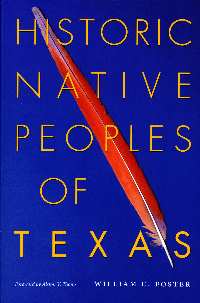 |
Historic
Native Peoples of Texas Hence
a
great deal of new material has been made available to
researchers, and Foster, a former lawyer who has
transformed himself in retirement into an award
winning historian, has managed not only to synthesize
much of this new research but to wrangle it into
manageable chunks. Due to
the sheer size of Texas, geographical, climatic,
ecological and ethnographic gradations are presented
in the form of eight separate study areas: between the
Lower Brazos and the Lower Colorado Rivers, between
the Lower Colorado and the San Antonio Rivers, the
Central Texas Coast, South Texas, the Texas
Trans-Pecos, the Texas Southern Plains, Northeast
Texas, and the Upper Texas Coast.
For each study area he presents an easily
digestible geographic and ecological overview,
followed by chronological descriptions of the relevant
Spanish and French expeditions in the area and the
nature of the documents spawned by those excursions. “Like
our
ancient ancestors, we (at least in Texas) are still
hunters and gatherers. Today
we hunt white-tailed deer, wild turkey, ducks, and
geese; we gather and pick pecans, mustang grapes, wild
plums, and dewberries to put up.
And in the wild today we still see jackrabbits,
cottontails, armadillos, coyotes, sandhill cranes, and
buzzards, all Texas residents 10,000 years ago. And when we dress up today,
we still sport tattoos and wear brightly colored
beads, earrings, fur coats, and feathered hats. And when it’s all over, like
our ancient tribal ancestors, we still cremate or bury
our dead with flowers and a faith in a life
hereafter.”
reviewed by Charles Swenson |
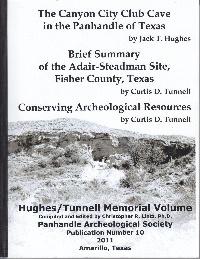 |
Hughes/Tunnell Memorial Volume: The Canyon City Club Cave in the Panhandle of Texas by Jack T. Hughes; Brief Summary of the Adair-Steadman Site, Fisher County, Texas by Curtis D. Tunnell; Conserving Archaeological Resources by Curtis D. Tunnell Compiled and edited by Christopher R. Lintz Panhandle Archeological Society, Publication Number 10 First ed. 2011 ISBN# none oversized paperback This important publication serves two purposes: it introduces those unaware to two interesting archaeologists who worked intensively in a part of Texas not all that many are familiar with; and secondly, by publishing several interesting and significant studies they undertook, allows us insight into their work. Archaeologist and editor Christopher Lintz calls Jack T. Hughes (1922-2001) "the undisputed Dean of Panhandle Archaeology". Hughes spent over 35 years surveying and excavating sites in the Panhandle. He was a popular professor at West Texas State University (WTSU, now West Texas A&M), and one of his students, Curtis Tunnell, is also the focus of this publication. Perhaps most importantly, Hughes held the position of Curator of Archaeology and Paleontology at the Panhandle Plains Historical Museum (PPHM) where he instituted the first catalogue system for the museums large and varied collection. Curtis D. Tunnell was a student of Jack Hughes who eventually became the first Texas State Archaeologist and the second Executive Director of the Texas Historical Commission. Tunnell's first job, fresh out of high school was custodial, sweeping floors at the PPHM; It is there where Tunnell met Hughes. Hughes and Tunnell would publish many papers together, and worked many sites together, including the Canyon City Club Cave Site. Tunnell went on to work with Ed Jelks where he participated in several important excavation projects for the Texas Archaeological Salvage Project. The publication includes Tunnell's banquet speech honoring Hughes presented as the first Floyd V. Studer Lecture of the Panhandle Arceological Society in 1977. The speech is a great read-- you will wish you were there as it is both witty and informative. Tunnell's short paper on the Adair-Stedman Site, an important and pristine folsom artifact assemblage is very interesting-- the Panhandle Archeological Society does us all a great favor in reprinting it. Lintz presents us with what he and many others consider a long overlooked research study that, despite being unpublished remains highly influential. For example, Hughes' Canyon City Club Cave data were instrumental in studies undertaken by David Baerreis and Reid Bryson that have helped us better understand paleoenvironmental conditions in the Panhandle. Lathel Duffield studied the faunal remains recovered during the excavations as part of his dissertation study that also provided insight into Southern Plains paleoenvironmental conditions. The Canyon City Club Cave Site does contain some misunderstandings about Plains archaeology but those are reasonable when you know you are reading the result of a 50 year old study. These errors do not take away from all of the other observations that Hughes made that are still relevant. It is an interesting read. I applaud the Panhandle Archeological Society for rerinting this publication. I urge all of you who are interested in archaeology to support this kind of publication. The archaeology of the Texas Panhandle is incredibly fascinating and yet not well known. I became entranced by its mysteries and wrote my thesis about a site in this region. I know you will enjoy this book! The Panhandle Archeological Society does have a website (click here to go there), but does not take orders online just yet. To get a copy of this book, follow the instructiuons below... Choose format: Paperback $15.00 ea. also
available on Compact Disk (CD) $15.00 ea
PLEASE SPECIFY when ordering. METHOD OF
PAYMENT:
Checks or money orders (sorry no credit cards accepted) Payable to:
Panhandle Archeological Society or PAS
Add Postage (Continental US only) $4.00
Postage for the First Publication
$2.00 For each Additional
Publication
Send to: Publications
Panhandle
Archeological Society
P.O. Box
814
Amarillo,
Texas 79105
reviewed by Bob
Wishoff
|
| Home | Gallery | Latest Finds | Back to Main Book Review Index |